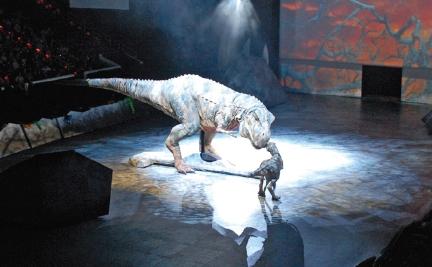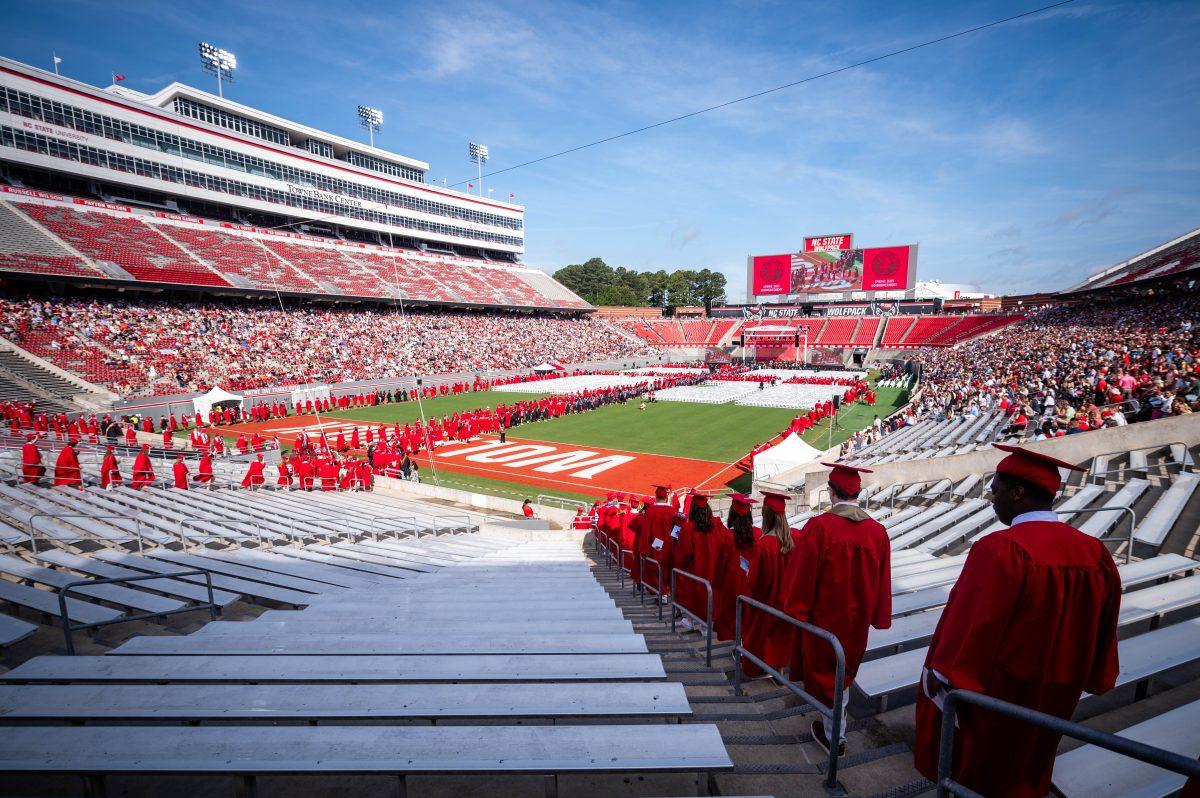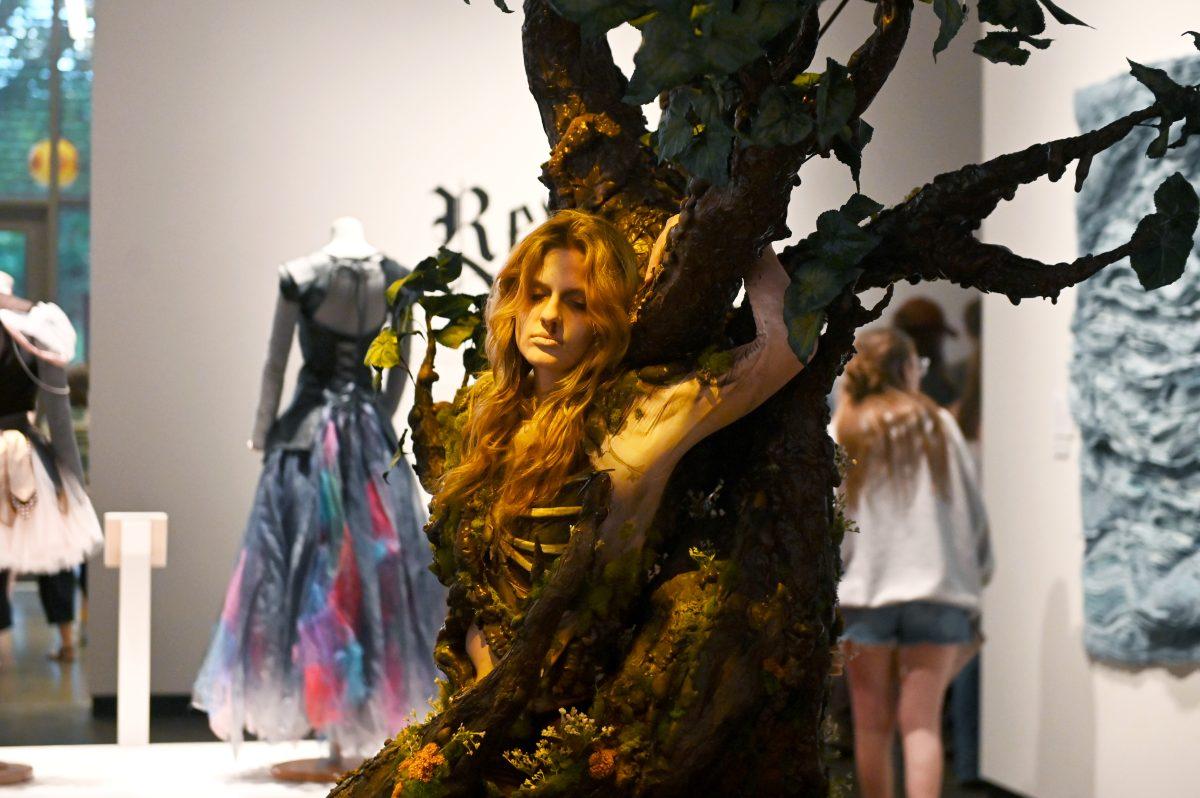What started out as an award-winning BBC television show, Walking with Dinosaurs, was transcribed into real life through iron, fiberglass and, in some instances, people who were fitted into puppet costumes. The Creature Production Company who were chosen for the recreation worked off of a 20 million dollar budget.
The show started in Australia, sold out for 10 weeks straight and made its way to North America, touring California, Illinois, Texas and, now, North Carolina.
The show takes place at Raleigh’s RBC center, host to various musicians, performers and the Carolina Hurricanes. With such a diverse venue it’s no surprise that Walking with Dinosaurs evolved out of the genre pool with its exhibition of paramount engineering coupled with a sweeping narrative of Earth’s history. Being best described as a show seen in Disney World, Walking with Dinosaurs exhibits colossal animatronic beasts, a grand musical score and a singular “paleontologist” narrator.
The show, which opened Oct. 22, welcomes families, students and adults alike.
Primed by a disorienting pitch black, which hid even the nostalgic ACC Tournament Champions flags to be seen, the audience was blanketed with a sense of mystery. Even the silence seemed to have volume. Then, with a single spotlight, and the help of two jumbo tele-screens, the narrator began telling the tale of earth, starting with the Triassic period, the first of the Mesozoic era.
The Tr iassic per iod was marked by a mass extinction at its beginning and end. Due to the rearrangement, portrayed by giant rocks moving across the arena, volcanoes spewed gasses and, compounded with the geographic location of Pangaea, which straddled the equator, temperatures were extreme.
This hostile environment was reason for the preceding extinction. The only flora that reproduced well were conifers and other gymnosperms, such as the modern day ginkgo bi loba. Gymnosperms reproduce by exposed seed and wind pollination unlike the lycopods and fern-trees, which needed a wet environment for reproduction.
Also notable during this time period was the emergence of true mammals such as Eozostroden, who is thought to be have been tiny in size and mostly nocturnal. Keeping instep, amphibians also began to evolve into more complex organisms resulting in “the earliest known turtle, Proganochely’s,” according to EnchantedLearning. com.
The show is vibrant in order to keep audience members attention, as media today is saturated with visually stimulating images. Walking with Dinosaurs facilitated that with its strong use of color and movement. The stage mechanics consisted of parachute type plants that would burst forth from the edges of the arena, propelled by air blowers. Conifers of the same material erupted from the center emphasizing the narrative of the paleontologist. At certain points of the story, symbolizing land movement, a rock formation in the arena breaks apart, moving to the corners of the stage, representing the forming of continents.
Continuing into the Jurassic period, the most famous and glamorized of all by John Hammond and his Jurassic Park, the paleontologist explained how restless Pangaea continued to split and rotate. Likewise the flora and fauna, direct by-products of land mass disturbance kept pace, introducing exotic flowering plants, insects and modern day reptiles like the alligator.
Due to the abundance of food and the size to which it grew, dinosaurs responded with gigantic growth. This is where the largest of all in Walking with Dinosaurs makes his debut, the Brachiosaurus. The Brachiosaurus, measuring 36 feet tall and 54 feet long, peers into the crowd with its long neck.
Closing with the Cretaceous period, the third and last of the Mesozoic era, Tyrannosaurus Rex makes her appearance in a skit where the 20-feet-tall, raging beast protects baby T.Rex from other large predators Torosaurus and Ankylosaurs.
Where as before the dinos had been relatively docile and placid, T.Rex empitomizes her stereotype with white daggers for teeth, craggy green skin and a body language that speaks of the inherent ferocious beast she is. For example, T.Rex can eat 140 lbs of meat in one bite. However, with one advantage comes a disadvantage, such as the fact provided by Dinosaurian World professor Mary Higby Schweitzer that T.Rex’s arms were shorter than an average human’s and had only a 20 degree range of mobility, meaning a Chinese finger trap was out of the question as it couldn’t touch its index fingers together in the slightest.
Dr. Schweitzer, accompanied by a group of students which included a lab assistant, one undergrad and a few doctoral students, all enjoyed the show with minimal critiques.
“It was very impressive,” said Drew Eddy, doctoral student in Marine, Earth and Atomosphere Science.
Elizabeth Johnson, also a doctoral student of Marine, Earth and Atmosphere Science agrees.
“[We saw flaws] but they were incredibly minor because of all we know,” Johnson said.
Eddy also spoke of how gratifying the show was in the sense of being able to see the animals alive.
“Biologists have the luxury of observing their subjects. We have bones,” Eddy said.
Both Eddy and Johnson admitted to being infatuated with dinosaurs from an early age, telling their teachers they wanted to grow up to be paleontologists.
Dr. Schweitzer affirmed that she too had fallen in love with the creatures early on and finding them is among her favorite things to do in life.
Dr. Schweitzer participates every summer in a field camp, crew-chiefed by Johnson, and is set amidst the mountains of Montana. Dr. Schweitzer speaks of the cramped living quarters, dust and bones that theme everyday camp life and the isolation brought by the search for bones. Interest meetings will be held in the spring.








